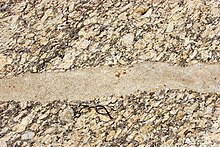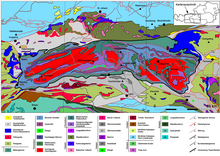Crystalline complex

A crystalline complex, especially in compositions often shortened to crystalline (e.g. in Black Forest crystalline and Tauern crystalline ), is a complex, larger rock body that consists of low to high-grade metamorphic rocks and often also of unmetamorphic plutonites . These two rock groups are traditionally grouped together under the term crystalline rocks to distinguish them from non- metamorphic and weakest metamorphic sedimentary rocks . The metamorphic rocks of a crystalline complex are mostly medium-grade “dynamometamorphic rocks” such as gneiss , mica slate and amphibolite slate , less often high-pressure rocks such as granulite or eclogite . These metamorphic rocks, which can be very old in terms of geological history , are sunk deeply into the earth's crust at least once in the course of their genesis (in some cases well over 10 kilometers deep) and brought back relatively close to the earth's surface (a few kilometers deep) through mountain formation (a few kilometers deep) (exhumed) ). The unmetamorphic, mostly granitoid plutonites are the result of large amounts of magma that penetrated into the exhumed metamorphic rock complexes in the late phase of mountain formation and crystallized there. As a result of sustained uplift of such crustal areas and the associated continuous erosion or denudation , mixed plutonic-metamorphic rock suites can now bite out over large areas as components of so-called trunk mountains on the earth's surface . In regionalgeologischem related to pre- Mesozoic crystalline complexes, regardless of whether they superficially pending or not, as a crystalline basement rocks called. Regions whose subsurface is made up of low-grade metamorphic rocks ( phyllites , green slate ) are not always added to the crystalline complexes in the regional geology of Germany , but are sometimes referred to as “slate mountains”. They often form the so-called slate shells of the higher metamorphic areas or the transition zones between unmetamorphic slate mountains and “actual” crystalline.
Larger and smaller crystalline complexes that emerged from the Variscan orogeny and therefore belong to the Variscan basement, characterize the surface geology of Central Europe. A particularly large crystalline complex is the Bohemian mass . To a lesser extent, crystalline (Variscan) basement rocks u. a. in the Black Forest , Odenwald and Spessart as well as in the Thuringian Forest , whereby these crystalline rocks belong to a different structural unit of the varistic than the predominant part of the Bohemian mass, namely the so-called Central German Crystalline Zone (also called Central German Crystalline Threshold). Particularly old crystalline is particularly large on the continental shields .
Crystalline also comes to light in geologically young fold mountains such as the Alps . This is partly due to the incorporation of pre-Mesozoic crystalline complexes (so-called old crystalline ) into the Alpine orogen (e.g. the Mont Blanc massif ), but partly these crystalline complexes were only formed - at least partially - in the course of the formation of the Alps (e.g. B. the Tauern massif ).
Individual evidence
- ↑ Klaus Reinhold: Depth of the crystalline surface in Germany. Federal Institute for Geosciences and Natural Resources, Berlin 2005 ( PDF; 7.1 MB ), p. 7
- ↑ Roland Vinx: Rock determination in the field. 4th edition, Springer-Verlag, 2015, ISBN 978-364255418-6 , p. 18
- ↑ sometimes even more than 100 kilometers, see Hans Massonne, Allen Kennedy, Lutz Nasdala, T. Theye: Dating of zircon and monazite from diamondiferous quartzofeldspathic rocks of the Saxonian Erzgebirge - hints at burial and exhumation velocities . In: Mineralogical Magazine . tape 71 , no. 4 , 2007, p. 407-425 ( PDF; 2.5 MB ).
- ^ O. Adrian Pfiffner: Geology of the Alps. 3. Edition. UTB 8416. Haupt Verlag, Bern 2015, ISBN 978-3-8252-8610-1
